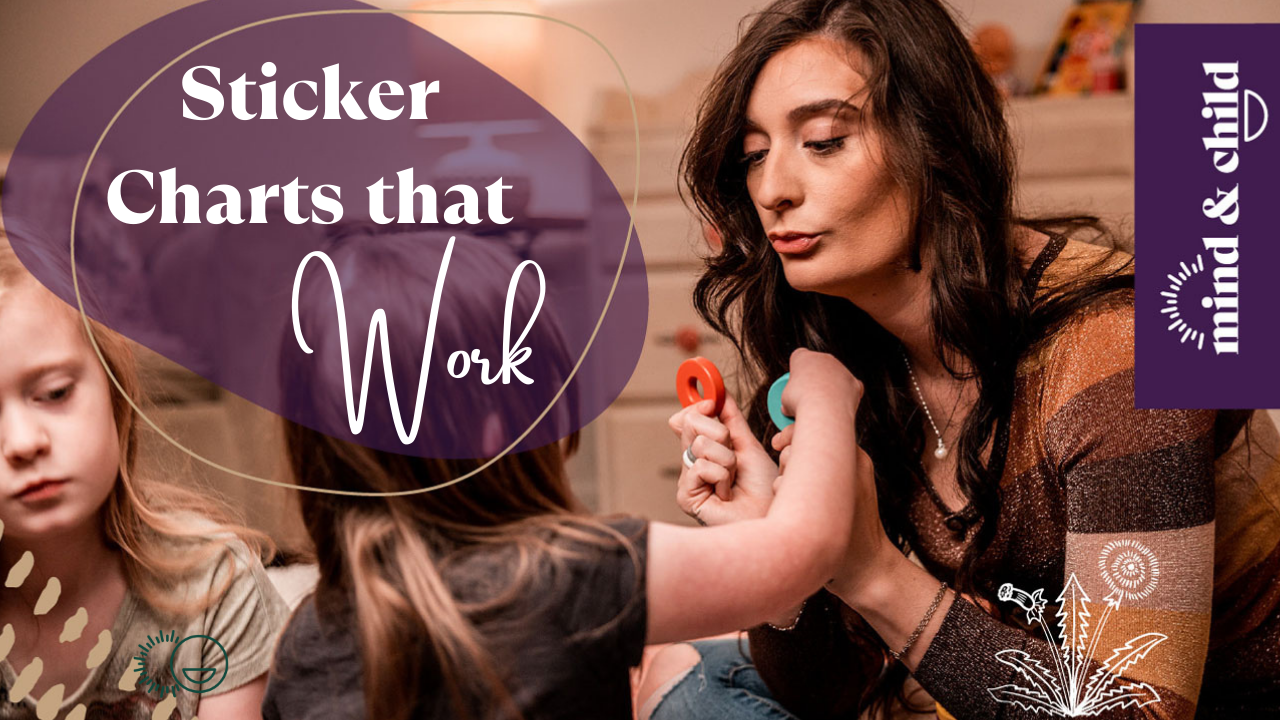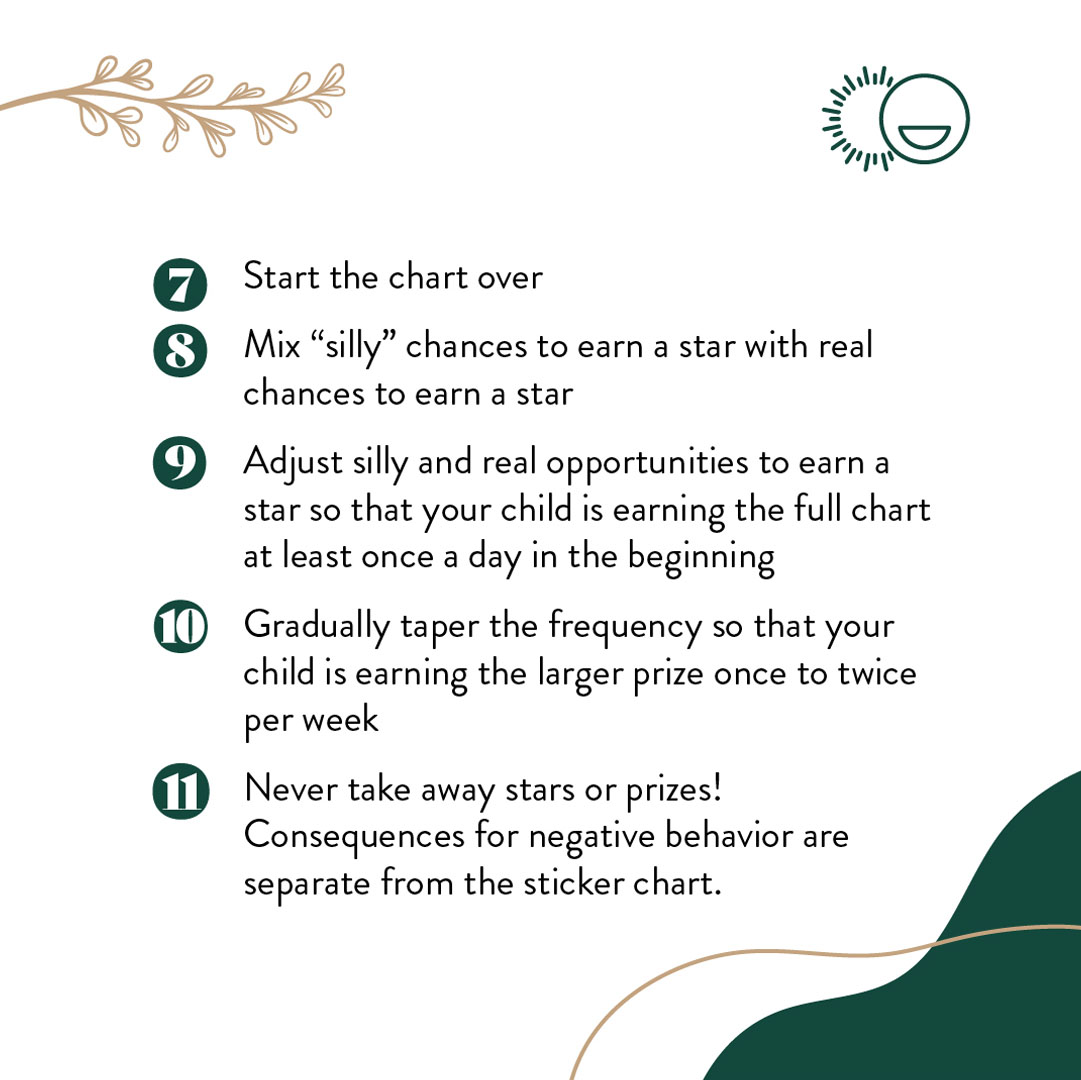Sticker Charts that Work
May 30, 2022
Oh sticker charts, sticker charts;
Why-fore though not work, sticker charts?
We LOVE sticker charts. We love using them in our own homes and love teaching other parents how to use them. By “sticker charts” we mean any type of structured system where a child is reinforced for a positive behavior (stickers aren’t required). We also know, through research on child development, that these reinforcement systems are highly effective for increasing the behaviors of which we want to see more!
However, when we bring up the idea of sticker charts to parents, we are often hit with the resistance that comes with the sting of prior failed attempts. We frequently hear things like:
“We tried sticker charts, but he was never motivated enough to really care”
“We used one for a while, but she lost interest”
“It was just too much work to keep up”
It’s easy to make a sticker chart that is quick to fail. But it’s even easier to make a sticker chart that works! Let us walk you through our simple guidelines for making one that works!
The first thing to remember: Sticker charts are REINFORCEMENTS not BRIBES
Before we get into talking about the steps of sticker charts, it’s important to note the difference between reinforcements and bribery.
A bribe is when you give a treat before the desired behavior has occurred: “If I give you a cookie, will you take out the trash?”
A reinforcement is when your child earns a treat after the desired behavior has occurred: “Thanks for taking out the trash! How about a cookie for your hard work?”
Our goal with sticker charts is to provide a reinforcement for a desired behavior. That little reinforcement, whether it be a cookie, a sticker, or a star drawn on a piece of paper, provides a tiny boost of dopamine in the brain. Dopamine is the “feel good” neuromodulator that makes you want to do that thing again. When we learn new habits, we need bursts of dopamine to make that habit stick. Eventually, we become more intrinsically motivated to accomplish the behavior. But initially, we often need a little extra “boost” to convince us we want to do it again.
Let’s get to it. Here are our 11 easy steps for making sticker charts work:
- Pick ONE, specific, attainable goal for your child. Oftentimes, parents pick goals that are too broad (“be good”) or un-attainable (“be kind to your sister for an entire month”). Your child should know exactly what behavior you are expecting. And the behavior should be something you can easily “catch” and reinforce. We have used the following goals in our homes:
- Do what mommy or daddy asks you to do the first time
- Use a quiet to medium volume when talking
- Put your toys back in the correct boxes when done
- Using kind words with a sibling
- Keep the chart simple. We literally draw a five or ten square grid on a piece of notebook paper and put it on the refrigerator with a magnet. We have found that when parents start Pinterest-ing cute charts, or, buying printable reinforcement systems, the system can quickly get out of hand. Keep it simple! Make something you can stuff in your purse and take with you to the grocery store if you need to.
- Pick a small prize and a large prize. The small prize is what your child earns for accomplishing their goal. This may be a simple sticker you put on one of the grid squares. Or it can be as simple as a hand-drawn star in the grid. The larger prize is what your child earns when they fill up the grid. Choose whatever is motivating for your child. But be cautious to not choose a prize that is too big. The sticker chart is not a one-and-done thing, they will be earning that larger prize multiple times! Some simple ideas for larger prizes are:
- Earning a matchbox car
- Going to the dollar store to pick out a prize
- Getting ice-cream with a chosen adult
- Getting to watch an extra show after dinner
- When you introduce the chart, explain the rules, and immediately start practicing. Sit down with your child and clearly explain what their one goal is. Give a few examples of what it will look like for them to earn a sticker. Also introduce any rules to the sticker chart. For example, one of our rules is, “If you ask for stickers, you don’t get stickers.” Then, start practicing! Mix in a few silly options, with real options. For example, if your goal is, “Do what mommy asks you to do the first time,” you may practice like this:
- “I’m about to ask you to do something, let’s see if you can listen….run in the front yard and get the mail! Great job, you listened, you get a sticker!”
- “Eyes on me. Spin around three times! Woo hoo, you did what I asked, you get a sticker!”
- “Look and listen. Pat your head and rub your tummy. Wow! What a great listener, here is your sticker!”
Notice that when we first introduce the chart, we use an attention-grabbing phrase before we ask our child to do to something, like, “I’m about to ask you to do something, let’s see if you can listen.” This helps prime their brain to listen. Then, when you are not actively practicing the sticker chart, but you need them to listen, you can use that phrase to get their attention. You will eventually wean off using this phrase. However, it will still come in useful in chaotic settings where you need a trick to grab their attention!
- Within the first hour of introducing the chart, make sure your child earns all five (or ten) of the stickers. This is so important and is the missed step that often causes sticker charts to fail. You child must immediately see the connection between doing what my parent asks, earning a sticker (woohoo, feels good!), and earning a bigger prize (woohoo, feels even better!). If they do not see this connection immediately, they will lose interest. Don’t worry, the goal in all of this is for your child to become intrinsically motivated to do the thing, without an external reward. However, this is the first step to get to that point.
This means that when introducing the sticker chart, you will mix real opportunities for meeting the goal (“would you put your Legos in the box?”) with “silly” opportunities, “Spin around three times!”
- Go get the larger prize. Whatever that is, be prepared to go get the larger prize within the first hour of introducing the chart.
- Start the chart over. This is why it is so important to keep it simple! Throw the old chart away (or, keep it if you or your child are sentimental), and re-draw a new grid on a new piece of paper.
- Continue mixing “silly” chances to earn a sticker with “real” chances. The first few charts, you will still be “manipulating” it so that your child has plenty of opportunities to earn a sticker. You will gradually phase out the “silly” options.
- In the beginning, aim for your child earning the larger prize once per day. This keeps it motivating. You may need to alter what the larger prize is, to keep it interesting. Some ways of making this fun are:
- Select a few possible larger prizes, write them down, and put the pieces of paper in a bowl. Let your child choose the larger prize, lotto style.
- Have the options for larger prizes written out on a piece of paper or dry erase board. Let your child choose each time you start the chart over.
- Give your child the chance to think of their own larger prize! But, let them know you have veto power.
- Taper the frequency of opportunities to earn stickers, so that they can earn the larger prize once per week. This means that you are phasing out some of those “silly” options to earn a prize that you have been sprinkling in. So, that after your child is eventually earning stars all of their own accord.
- Never take away stars or prizes! Once your child earns a star, it is theirs to keep! If they engage in a negative behavior, you need to address that behavior separately from the chart. Think about your job. If you do your work and meet your goals, you earn your paycheck on Friday. On Monday, if you show up late, flip over a desk, and curse out your boss, your paycheck from last Friday does not get taken away. You may get fired, but you still have that paycheck!


Have you checked out our free video, Love, Like, Enjoy, yet? This video is one of 27 short videos from our Parenting 101 Course.
-Dr. Erin Avirett and Dr. Jordana Mortimer
Want more like this? Transform your home with our Parenting 101 Course, and weekly tips from two Child Psychologists.
Stay connected with news and updates!
Join our mailing list to receive the latest news and updates from Mind + Child.
Don't worry, your information will not be shared.
We hate SPAM. We will never sell your information, for any reason.



